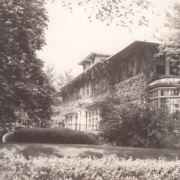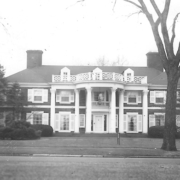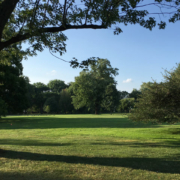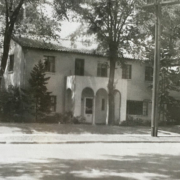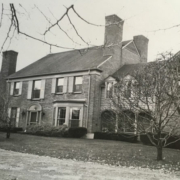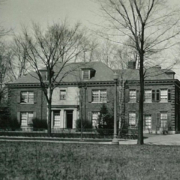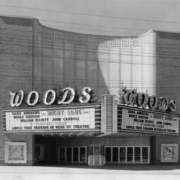Historical Architecture of Grosse Pointe – The Crowley Family
Last week we explored the history of 28 Beverly Road, a superb example of a Mission Revival style home designed by Alpheus W. Chittenden for banker William P. Hamilton in 1911/1912.
A couple of weeks ago we presented the history of 44 Beverly Road that was completed for the younger of the Crowley brothers, William. This week we will take a closer look at the Crowley family and the two stunning homes on Lakeland that were once owned by Joseph and Daniel Crowley. The father of the three brothers was Conellus Crowley.
In 1825, Conellus Crowley was born in County Kerry in Ireland. It was reported “Mr. Crowley, left Ireland around 1844 as part of a huge wave of Europeans, chiefly Irish and German, who came to the United States in the mid1800s to escape despotism and famine in their native lands”. Source: www.findagrave.com. Following several years of living in Boston, it is believed the Crowley family arrived in Detroit around 1851 where Mr. Crowley began business as a grocer at the corner of Fifth and Porter Streets, in Corktown. He and his wife Catherine Brosnan Crowley (also from Ireland) had a daughter and three sons. Nellie (October 4,1853 – August 10, 1898); Joseph (April 26, 1862 – November 1, 1925); Daniel (March 13, 1864 – April 6, 1936); and William (February 13, 1866 – February 19, 1927).
The eldest son Joseph J. Crowley Sr. began his career working for his father at the grocery store after school and on Saturdays. Having graduated from high school he attended Goldsmith’s Bryant and Stratton business college, mastering everything the college could teach him about accounting and commercial law. Following graduation, in 1880, he began his career at Burnham-Stoepel Co., a dry goods company, where he served for many years as credit manager. It is reported “he was greatly responsible for the growth of the firm and became one of the states leading credit men”. Source: The Windsor Star (November 1925). Joseph also played a huge part in creating the Crowley Brothers Company, which would become one of the leading dry goods firms in Michigan. In partnership with him in the business were his brothers Daniel and William.
Joseph Crowley resided at 243 Lakeland; a grand 26-room Tudor style home believed to have been designed by Richard Raseman in 1915. Located on four lots the 9,572 sq ft 9-bedroom residence has a gallery entrance room with a paneled inglenook fireplace, as well as a quarry tiled garden room. The drawing room, large dining room, and finely paneled library all have fireplaces. On the third floor was once a 25’ x 23’ sq ft ballroom with a stage. Throughout the home are stained glass windows, and beautifully carved woodwork. The exterior has a striking carved limestone entrance along with two limestone framed bay windows (on the left-hand side) that run from the first and second floors. The attached five-car garage had a three-bedroom apartment located above it. Following the passing of Joseph Crowley (in 1925) we understand Joseph’s daughter Katherine lived at the property with her husband, prominent attorney Dehull Norman Travis, until the family sold the residence in the 1960s. Following which the property was owned by Lorenzo “Red” Browning, the former mayor of Grosse Pointe City. The color photo is courtesy of GoogleEarth.
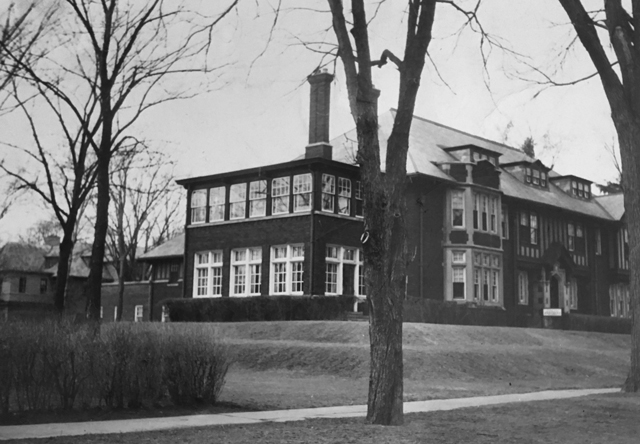
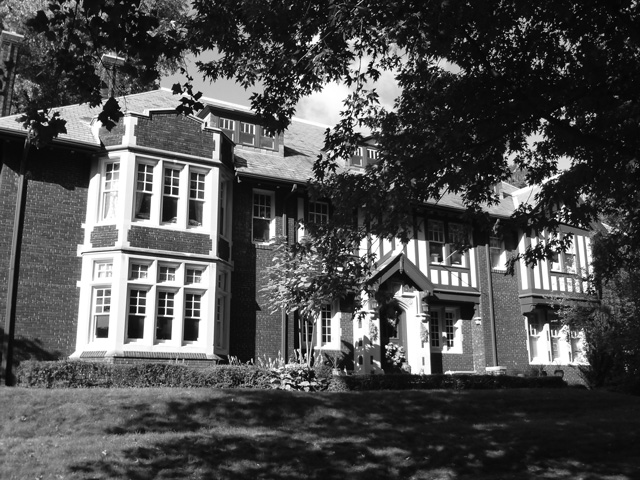
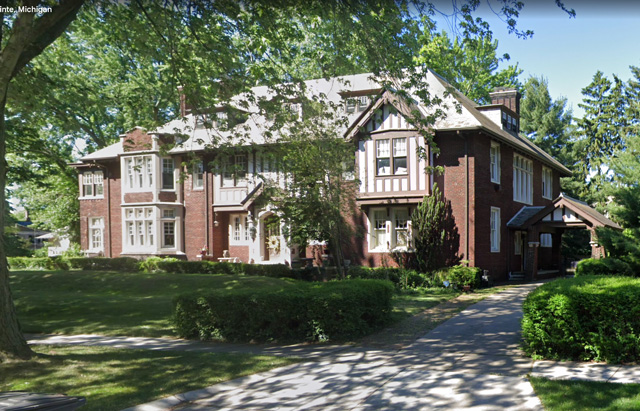
Daniel T. Crowley began his career as a bookkeeper with a company that was a wholesale dealer in dry goods. In 1886 he went to work for the Peninsular Stove Co., where he would work for over 30 years, becoming vice president and general manger in the 1920’s. During this period, he was also vice president of the Crowley Brothers Co., and a director of the Crowley-Milner Company. He was also a prominent figure in Grosse Pointe City – Mr. Crowley was the president of the board who instigated the purchase of the land (on July 14, 1910) where Neff Park is now located. Upon the purchase of the site for the park, one of the earliest structures to be constructed was the gazebo, built in 1912 by architect Bernard C. Wetzel & Company. The gazebo was completed in the Art & Crafts architectural style, an extremely popular approach throughout the United States during this era. Photo courtesy of Katie Doelle.
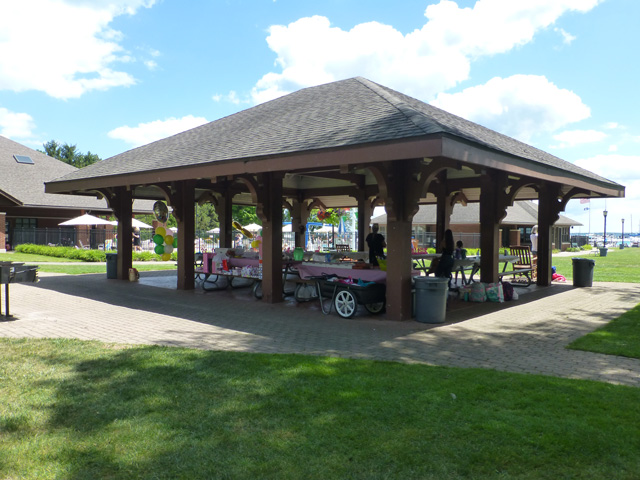
Daniel Crowley resided next door to his older brother, at 203 Lakeland. This stunning home, named “Edgestone” was completed in 1914-1915 (shortly before Joseph’s home) and was designed by Bernard C. Wetzel. The property is located on the edge of Lake St. Clair, directly adjacent to Neff Park.
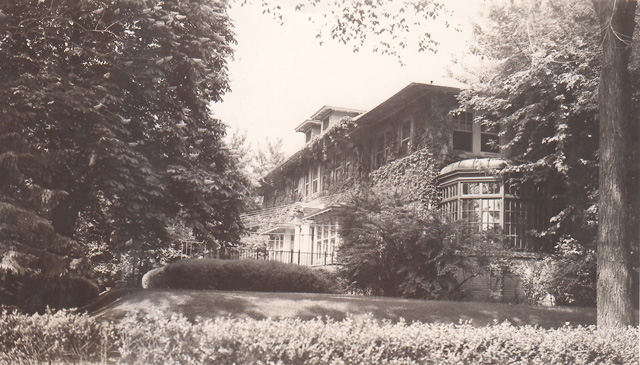
The exterior of this “artistic home” created in the Prairie style was originally finished in light gray brick and plaster. The two glass-enclosed porches on the first floor, overlook the lake and once had two sleeping porches located above. Inside, the hall, vestibule, and the dining room had a mahogany finish, while the living room, with a large fireplace, had floors finished in quartered oak. On the third floor was a ballroom, while in the basement was a billiard room with an open fireplace. On the south-east corner of the first floor was(is) a glass enclosed breakfast room that provides a perfect view of the lake. Image courtesy of GoogleEarth.
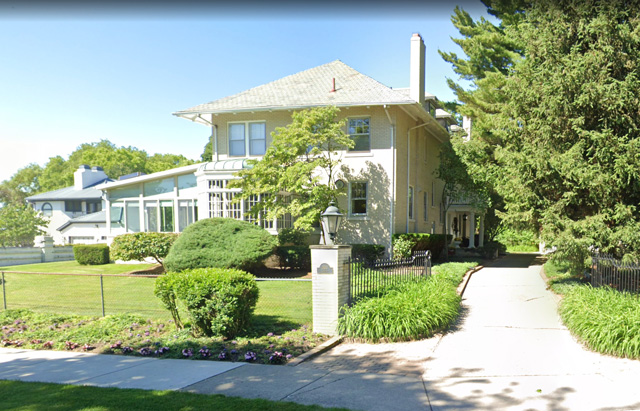
The architect of 203 Lakeland, Bernard Christian Wetzel, was a self-employed architect and resident of Detroit for over 60 years. Prior to starting his own business in 1907, he was associated with several leading architects in Detroit. During the proceeding years he worked throughout the area creating many fine commercial structures (including various public-school buildings) and residences. In 1922 Clarence Monroe Burton wrote “his creations are of the most artistic character. He has the ability to combine utility, convenience and beauty”. Source: The City of Detroit, Michigan, 1701-1922, Volume 3 by Clarence M. Burton. It appears, aside from the gazebo, the only other project he completed in Grosse Pointe was 203 Lakeland.
The youngest of the Crowley brothers, William C. Crowley resided at 44 Beverly. This stunning Spanish Revival style home was designed by Richard Raseman in 1916-1917. Mr. Crowley, like his brothers, began his career in the wholesale dry goods business in Detroit around 1882. You can read the full story by clicking here.
In 1909, the Crowley brothers, along with William Milner, joined forces to create the Crowley-Milner Company, generally referred to as Crowley’s – a high-end department store chain. Its flagship store, corporate office, and warehouse complex occupied two blocks in downtown Detroit for almost 80 years. The store was a direct competitor of the J. L. Hudson Company. It is reported “the brothers envisioned the store as one of the highest quality retail operations in Detroit. They stocked the store with luxurious clothing and gifts imported from Europe and opened a full-service restaurant and grocery store. Within ten years, the Crowley, Milner & Co. expanded its building and was the largest department store in Michigan. Sadly, in 1999, 90 years after the company was founded, the Crowley-Milner Company ceased operation and its assets were sold. Source: Wikipedia.
The Crowley family has left a legacy. The once small unknown family from County Kerry in Ireland not only helped transform the retail scene in Detroit, but also the architectural scene in Grosse Pointe.
* Photos courtesy of the Higbie Maxon Agney archives unless stated.
** Research, information, and data sources are deemed reliable, but accuracy cannot be fully guaranteed.
Written by Katie Doelle
Copyright © 2024 Katie Doelle

